Biography
Interests
Nicholas Kavana, J.
Department of Microbiology and Parasitology, St. Francis University College of Health and Allied Sciences, Tanzania
*Correspondence to: Dr. Nicholas Kavana, J., Department of Microbiology and Parasitology, St. Francis University College of Health and Allied Sciences, Tanzania.
Copyright © 2021 Dr. Nicholas Kavana, J. This is an open access article distributed under the Creative Commons Attribution License, which permits unrestricted use, distribution, and reproduction in any medium, provided the original work is properly cited.
Abstract
There has been many historical epidemics in Tanzania in the last century. COVID-19 is a new
epidemic, which we have never experienced before. The objective of our study is to highlight the effect
of preventive and control measures of COVID-19 pandemic to reduction of STHs transmission in
rural areas of Tanzania.
This present study based on hospital laboratory records of stool samples submitted from 1 June
2019 to 30 June 2020. Data were sourced from laboratory record books of St. Francis Referral
Hospital, Ifakara, Tanzania.
A total of 19,767 patients submitted stool to SFRH laboratory from 1st June 2019 to 30th June 2020.
June to December 2019 were 12,517, positive cases were 23 and January to June 2020 were 7,250,
positive cases were 6. Species of helminthes were Ascaris and Hookworm and age distribution was
between 10-79 years. Mag’ula village had many patients infected with soil transminted helminthes
than other villages. The age group of 30-39 years had many patients infected with soil transmitted
helminthes than any other age group. Hookworm was more common than Ascaris. Females were
more infected with soil transmitted helminthes than males.
We concluded this study basing on the laboratory results of one year period, six months before
and six months during the implementation of the prevention and control measures (specifically
handwashing) of COVID-19 pandemic. The outcome of this study has showed that handwashing
during COVID-19 pandemic had effect on transmission of soil transmitted helminthes in rural
areas.
Introduction
Coronavirus disease (COVID-19) is a mild to severe respiratory illness caused by a coronavirus and
characterized by fever, coughing and shortness of breath. The virus is mainly transmitted through droplets
generated when an infected person coughs, sneezes, or exhales. These droplets are too heavy to hang in the air,
quickly fall on floors or surfaces. Human can be infected by breathing in the virus if is within close proximity
of someone who is infected, or by touching a contaminated surface and then your eyes, nose or mouth [1]. At
the end of 2019, a novel coronavirus was identified as the cause of a cluster of pneumonia cases in Wuhan,
the capital city of Hubei province in China [2]. In February 2020, the World Health Organization (WHO)
declared coronavirus disease 2019 a Public Health Emergency of International Concern (PHEIC) [3]. In
the African Region, the coronavirus disease 2019 spread to 46 of the 47 countries and caused unprecedented
societal and economic disruptions. The measures taken to curb the pandemic included closure of borders
and schools, restriction of travel, trade and mass gatherings, reduction of economic productivity and public
services [4].
Soil-transmitted helminths (STHs) form one of the most important groups of infectious agents and are the cause of serious global health problems [5]. Globally, the most important STHs are roundworms (Ascaris lumbricoides), whipworms (Trichuris trichiura) and hookworms (Necator americanus or Ancylostoma duodenale) [6]. The greatest numbers of STH infections occur in Sub-Saharan Africa, East Asia, China, India and South America [7].
Inadequate hygiene and poor health care systems and facilities, as well as social indifference, make this situation worse. In the developing world, inadequate water supply and sanitation, as well as crowded living conditions, and low levels of education, make the poor susceptible to infection and disease [8]. Human STHs are fecal-borne infections, and transmission occurs either directly (hand-to-mouth) or indirectly (through food and water). Sanitation is the only definitive intervention that eliminates these infections [9]. In Tanzania, on 16 March 2020, the Ministry of Health, Community Development, Gender Elderly and Children (MOHCDGEC) announced the first case of COVID-19 in the country. The victim was a Tanzanian national who came back to Tanzania after visiting Denmark, Sweden and Belgium. In response to this, the government took action to prevent and control the spread of the disease. The Prime Minister announced to close all schools, universities, religious and other social gatherings, also international travels were suspended. Preventive measures were also established in workplaces, standard COVID-19 preventive measures established were physical distancing, hand washing, wearing masks and thermol monitoring. The lockdown measures were lifted on 1 June 2020, schools and universities were opened. The aim of this study is to establish how preventive and control measures of COVID-19 has contributed to reduction of Soil Transmitted Helminths in rural areas in Tanzania where sanitation is poor.
Methodology
According to our objective, St. Francis Referral Hospital (SFRH) (Fig. 1) was chosen as our study area
because of its status and location. It is a referral hospital located in Ifakara, Kilombero district which is rural
area of Tanzania. It also serves as referral center for other health facilities from Ulanga and Malinyi districts.
Ifakara is located in southern central Tanzania between latitude 87′59′S and longitude 3640′59.880′E at
altitude 199m above sea level. Ifakara is in Morogoro region, has a population of 49,532 people. The people
of Ifakara are Ndamba, Pogolo, and Mbunga, as well as Masai and Sukuma who migrated here as pastoralists.
Main activities conducted here is rice cultivation, sugarcane and maize farming and fishing from Kilombero
river. The hospital also serves as a teaching hospital for St. Francis University College of Health and Allied
Sciences (SFUCHAS), Edga Maranta School of Nursing and Tanzania Training Center for International
Health (TTCIH).
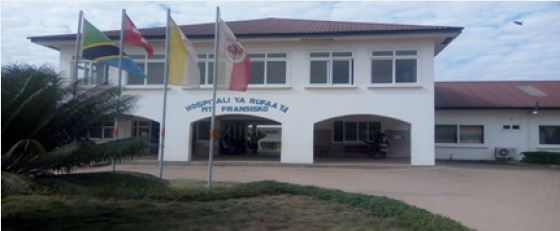
Hospital based Cross-sectional study design was adopted in this study.
This study aimed to investigate prevalence of STHs for patients attended SFRH laboratory during lockdown period of COVID-19 epidemic between 1 January to 30 June 2020.
The data are described basing on the independent variables (Age, Sex) and dependent variables (soil
transmitted helminths).
For the purpose of this study the positive egg results of soil transmitted helminthes were identified in the records book for patients who submitted their faecal samples to the SFRH laboratory between 1 June 2019 to 30 June 2020.
The proposal was submitted to the St. Francis University College of Health and Allied Sciences Ethical
Committee and the Director General of St. Francis Referral Hospital for ethical approval.
Time and financial constraints are limitation factors to this study.
Results
A total of 19,767 patients submitted stool to SFRH laboratory from 1st June 2019 to 30th June 2020. June
to December 2019 were 12,517, positive cases were 23 and January to June 2020 were 7,250, positive cases
were 6. Species of helminthes were Ascaris and Hookworm and age distribution was between 10-79 years
as shown in Table 1.
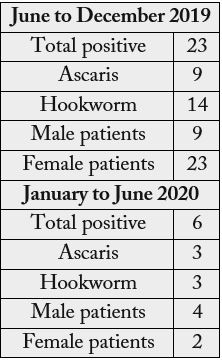
Mag’ula village had many patients infected with soil transmitted helminthes than other villages as shown in Table 2.
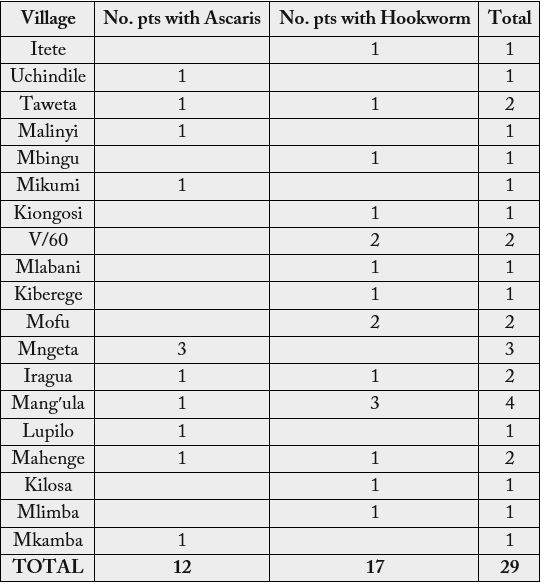
The age group of 30-39 years had many patients infected with soil transmitted helminthes than any other age group as shown in Table 3.
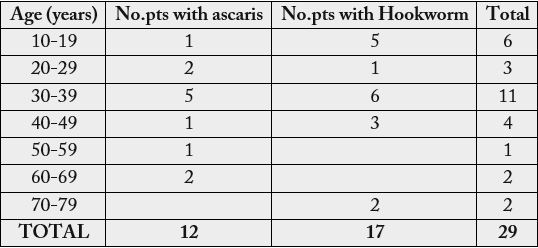
Females were more infected with soil transmitted helminthes than males as shown in Table 4.

Hookworm was more common than Ascaris as shown in Table 5.

Discussion
COVID-19 infected cases were first reported in the last December in Wuhan, China [2]. A public health
emergency was declared by the World Health Organization (WHO) on 30 January 2020 keeping in view
the international concern [9]. Coronavirus disease has affected 213 countries and territories around the
world. Its epidemiology was reported to change rapidly to over 118,000 cases in over 110 countries outside
China. The COVID-19 was reported to have reached Tanzania in early March 2020. The prevention
and control measures for COVID-19 started with effect 16 March 2020. The measures included: All
land borders, airports, and maritime ports of entry were closed to passenger transit. Authorities banned
large public gatherings, schools and universities were closed. The wearing of facemasks and handwashing became mandatory in all regions. Tanzania implemented the WHO guidelines of prevention and control
measures for COVID-19 like other countries in the world. The African region has a high burden of chronic
communicable and non-communicable conditions particularly among the economically active age group.
The focus of this article is on how prevention and control of COVID-19 reduced transmission of Soil Transmitted Helminths in rural areas of Tanzania through handwashing. During the outbreak of COVID-19 disease there was implementation of changes in population behaviors including handwashing. The facilities used for handwashing are as shown in Fig. 2 & 3. Handwashing is easy, cheap and effective way to prevent the spread of germs. Hand washing with soap inactivates and removes virus particles that may be on hands. At the same time, the soil transmitted helminthes are removed, causing them to fall apart. During the period of COVID-19 outbreak, handwashing became a habit to the population community. In this study the results shows that there was reduction in transmission of STHs in the area of study. The number of positive cases between January through June 2020 is lower than June through December 2019 as shown in Table 1. The number of positive cases in all villages where samples were examined was very low as shown in Table 2, this indicates that health education on handwashing as a preventive and control measure for COVID-19 was well implemented.
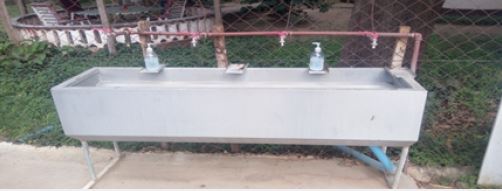

The age group between 30-39 years had more positive cases than other age groups as shown in Table 3, this could be because it is the age group which is very busy in various economic activities and are very mobile. In this study the number of positive cases was slightly higher in females than men as shown in Table 4. This could be because of the activities done by females in the rural areas it is easy for them to get infected. In Table 5 the number of Hookworm infection is slightly higher than Ascaris this could be the infection by Hookworm is also through penetration of the skin in bear feet. In rural areas many people do not wear shoes, this makes easy for hookworms to penetrate the skin.
Conclusion
COVID-19 is an infectious disease caused by a newly discovered strain of corona virus, a type of virus known
to cause respiratory infection in humans. This study evaluated the transmission of STHs between 1 June
2019 to 31 December 2019 when there was no implementation of handwashing and during implementation
of handwashing being prevention and control of COVID-19 infection in Tanzania in the first half of the
year 2020. The study has shown that handwashing in prevention and control of COVID-19 has effect in
prevention of transmission of Soil Transmitted Helminthes. The study cannot be conclusive because no
other study has been done elsewhere. It is therefore recommended for more studies.
Acknowledgement
I wish to express my appreciation to the Management of St. Francis University College of Health and Allied
Sciences, Laboratory staffs and the Director General of St. Francis Referral Hospital for their support in
this study. The study was funded by St. Francis University College of Health and Allied Sciences, Ifakara,
Tanzania.
Bibliography

Hi!
We're here to answer your questions!
Send us a message via Whatsapp, and we'll reply the moment we're available!